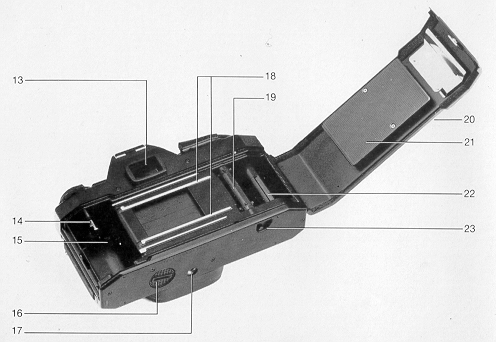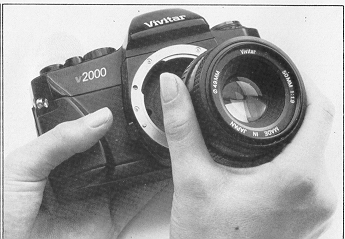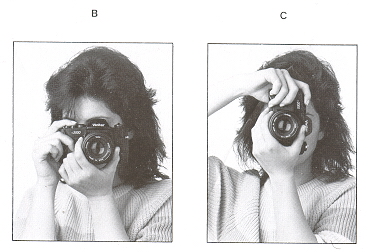If you find this manual useful,
how about a donation
of $3 to:
M. Butkus, 29 Lake Ave.,
High Bridge, NJ 08829-1701
and send your e-mail
address
so I can thank you.
Most other places would charge
you $7.50 for
a electronic copy
or $18.00 for a hard to read Xerox copy.
This will
help me to continue to host this site,
buy new manuals, and pay their shipping
costs.
It'll make you feel better, won't it ?
If you use Pay Pal, use the link below.
Use the above
address for a check, M.O. or cash.
To Vivitar V2000 PDF
version made from this HTML page
VIVITAR V2000
PDF MANUAL DIRECT FROM
MANUAL
- English only
CLICK BELOW FOR A PDF MANUAL
DIRECT FROM MANUAL
VIVITAR V2000 Mode D'Emploi
VIVITAR V2000 Manual de
Instrucciones
VIVITAR V2000 istruzioni per l'uso
VIVITAR V2000 Gebruiksaanwijzing
VIVITAR V2000 Japanese


Description of Parts
|
1. Shutter Speed Dial
2. Film Advance Lever
3. Shutter Release Button
4. Frame Counter
5 Strap Lug
6. Hand Grip
|
7. Lens Release Button
8. Hot Shoe
9. Film Rewind Crank
10. Film Rewind Knob/Film Compartment Opening Knob
11. Film Speed Dial
12. Film Speed Index
|

|
13. Viewfinder Eyepiece
14. Rewind Shaft
15. Film Chamber
16. Battery Compartment Cover
17 Tripod Socket
|
18. Film Guide Bars
1 9. Sprocket
20. Back Cover
21. Film Pressure Plate
22. Film Take-Up Spool
23 Film Rewind Button
|
Getting Started
You're probably anxious to take
a few pictures In fact, that's what we strongly recommend doing as soon as possible
First, we'd like you to do a set-up of the camera This will provide a system check
of basic camera functions as well as give you a feel for the camera. We urge you,
however, to read this instruction manual completely so that you can get the most
enjoyment from your camera.
Photo Tips
At various points in the book, we will give you some tips that will help you
take better pictures and care of your camera.
System Set-Up
Please fold out the photographs of your camera from the front and back covers
so that you can refer to the numbered call-outs of parts as we go along.
Before You Do Anything Else. . .
1. Pull up
the Rewind Crank (9). The Back Cover (20) will pop open Remove the white, protective
paper and discard it. Firing the shutter with this paper in place could cause damage
2 Gently close the door until you hear a soft click. Push down on the film
rewind knob to reseat it
Mounting/Removing the Lens
Your camera utilizes a bayonet 'K" mount (also referred to as "PK") and will
accept other lenses with a compatible 'K" mount designation (Webmaster: this is
a standard K-mount body, any K-mount would fit including AF lenses, alas they will
not auto focus but they are useable.)
To mount the lens:
 |
1. Match the red dot on the lens
with the red dot on the camera mount. (See Fig. A.)
2. Gently insert the lens into, the camera mount and turn it clockwise
until it clicks into position
3. To remove the lens, grasp the lens with your left hand and depress
the Lens Release Button (7) with your index finger while rotating the lens
to the left (counter-clockwise). Gently remove the lens from the camera
body.
|
Loading the Batteries
1. With a small coin,
rotate the Battery Compartment Cover (16) counter-clockwise and remove it DO NOT
use a screwdriver, because too much force may damage the Cover.
2. Holding
the Battery Compartment Cover in your hand, drop in and stack two LR44 or SR44 batteries
so that the plus (+) signs are facing up. (these are standard batteries available
from food stores to department stores)
3. Replace the Cover. The positive
(+) side of the batteries should face the (+) contact at the bottom of the battery
compartment Turn the Cover clockwise with a coin until it stops flush with the bottom
plate of the camera.
DO NOT OVER TIGHTEN
Battery Check
1. With your thumb, pull the Film Advance
Lever (2) out about 1/2 inch from the camera body. This is known as the 'stand off"
or "ready" position which activates the system electronics.
2. Put the camera
up to your eye and gently depress the Shutter Release Button (3) until you see one
of the three colored LED symbols (+ 0 -- ) light up When this occurs,
you know that your batteries are OK and the system circuits are complete
If you don't see any lights in the viewfinder, remove the batteries and make
sure their positive (+) orientation is correct.
3. Push the Advance Lever
back toward the camera body until it stops. This turns off the electronics, locks
the Shutter Release to avoid accidental firing, and avoids battery drain.
Photo Tip:
Some photographers replace the batteries in their camera on their birthdays or
before annual vacations Others take them to a camera store and check them If in
doubt replace them after one year or following extraordinarily heavy use
Battery Corrosion
Avoid damage to your camera.
Most all batteries will leak after long periods of inactivity If you don't plan
to use your camera for a month or more remove them and put them in a small plastic
bag for safety.
Loading the Film
1. Pull
up on the Film Rewind Crank (9) and open the Back Cover (20) all the way to the
right NOTE: When the Back Cover opens. it automatically resets the Frame Counter
(4) to '0' (zero),
2. Make sure the Film Rewind Crank is in the fully up
position
Photo Tip: Never load or unload film in direct sunlight
Find some shade or use your body to shade the camera when loading and unloading.
3. Insert the 35mm film cassette in the Film Chamber (15) Gently push down and
turn the Film Rewind Crank until it fully seats
4. Stretch the film leader
across the Film Guide Bars (18) Align the Sprocket (19) with the holes on the bottom
edge of the film leader.
5. Insert the film leader tip into one of the slots
of the Take-Up Spool (22). Check that the teeth of the Sprocket (19) are engaged
in the film's sprocket holes.
6. Using the Film Advance Lever (2). gently
advance the film with several short strokes until the film leader has made one rotation
around the Take-Up Spool.
7. Slowly and gently turn the Film Rewind Crank
(9) clockwise in the direction of the arrow until you feel resistance. You have
now created the proper tension and film flatness at the film plane.
8. Gently
close and apply pressure to the Back Cover until it clicks shut.
9. Advance the film and fire the shutter by pushing down on the Shutter Release
Button (3) three times until the black index mark in the Frame Counter Window (4)
is opposite the silver dot between the "0" and "2" The shutter is now wound and
ready for picture number one
Photo Tip: When you advance the film. check that the
Film Rewind Knob (10) turns at the same time. If it does. the film is advancing
properly. If it doesn't turn, the film has disengaged from the Take-Up Spool
and you should open the back cover and re-thread the film leader as explained
above.
Setting the Film Speed
1 Note the film speed
indicated on the film package or instruction sheet.
2. Turn the Film Speed
Dial (11 ) until the ISO speed of the film is opposite the white Film Speed Index
mark (12)
Setting the Shutter Speed
1. Turn the Shutter Speed
Dial (1 ) in either direction until the desired speed is opposite the white index
line and audibly cricks into position. NOTE: There are no intermediate
speeds in between those on the dial and incorrect exposures will result if interpolated
speeds are attempted. In the "B" (bulb) position the exposure system
is inoperative.
2. Shutter speeds of 1/125 or above are recommended
for brightly lighted scenes sports photography, and when fast films e.g ISO 400
are used.
Photo Tip: To avoid camera shake
(and blurred pictures). when using telephoto lenses. select a fast film and.
as a rule of thumb, use the focal length of the lens as an approximate shutter
speed guide.
Examples: 135mm lens = 1 /125 sec.: 500mm lens = 1 /500
sec
3. SHUTTER SPEED RECOMMENDATIONS WITH ISO 100 FILM
SUBJECT SHUTTER SPEED
Stationary subjects in low light .................1 to 1/1 5th sec
Indoors in normal conditions .................. 1/20 to 1/60
Outdoors on a clear day ........................ 1/125 to 1/250
Fast moving objects ...............................1/250 to 1/2000
Mountains and/or snow scenes ...............1/500 to 1/2000
Setting the Lens Aperture
1. With your right thumb,
pull the Film Advance Lever (2) away from the camera body about 1/2 inch to activate
the camera's electronics.
2. Hold the camera up to your eye, press down
part way on the Shutter Release Button (3) and turn the Aperture Ring on the lens
both ways and look at the glowing LEDs on the left side of the viewfinder RED means
STOP! Don't shoot! GREEN means GO! Shoot the picture The "+"
symbol means too much light. The "--" symbol means not
enough light
The circle in the center is like a traffic signal. It turns
from red to green when you can "go' Just turn the Aperture Ring in either direction
until you get a green signal If you're in low light, you may have to change to a
slower shutter speed in order to get a green signal.

|
Rotate the Shutter Speed Dial and the
Lens Aperture Ring a few times and practice getting the green light. |
(Webmaster: there are many different exposures you can take and get the correct
exposure. One "STOP" is equal to one shutter speed or one F-STOP.
So a light meter reading of 1/250 at F11 can also be 1/500 at F8 or 1/125 at F16.
The same amount of light will hit the film at any of those three exposures.
If you are at a 1/2 stop of the aperture, you can make the same adjustments.
Photo Tip: Since the Shutter Speed Dial and Lens Aperture
Ring are integrated in the exposure setting. you can use this versatile feature
to achieve some interesting results, e.g. use a slower shutter speed to blur
the background while you track a moving car or athlete.
This completes the system check of the camera. We urge you
to read on for more tips and important facts about your new camera.
Camera Holding Technique
 |
1. Cradle the lens
with your left hand so that your palm is directly under the lens and your
thumb and index finger are positioned on the Lens Aperture Ring as shown
in the photos. (See Fig B and C.)
2. Hold the camera
body so that your right index finger is over the Shutter Release Button,
your thumb is resting against the Film Advance Lever, and your middle and
fourth fingers are holding the Hand Grip (6). |
3. Bring the camera up to your eye and press your left
elbow against your body for camera support Keep your right arm relaxed.
Photo Tip: Take a tip from competitive athletes. Don't
be tight. To relax, take a deep breath and let it out slowly. Concentrate Don't
push down sharply on the Shutter Release Button. Apply pressure
evenly and smoothly. Lean against a wall, a fence,
or a friend to keep body movement and vibration to a minimum.
Shooting with
a telephoto or telezoom lens? USE A TRIPOD.
Focusing
Put the camera up to your eye and turn the Focusing Ring on the lens. As you
turn the ring you will see three different things happening in the viewfinder:
1. The entire screen will go from a blur to sharp focus. This allows you
to focus quickly in situations where you don't have time for "fine tuning" of the
focus.
2. The outside ring of the "donut" in the center of the viewfinder
will shimmer or appear partially broken and become sharp when you achieve focus.
This is one of your "fine tuning" focusing aids, which is especially useful with
long telephoto lenses and the viewfinder is not as bright
3. Inside the
"donut" is a split image rangefinder which separates the subject horizontally and
aligns it when in focus.
NOTE: Telephoto or telezoom lenses with an aperture of f/5.6 or slower may cause
the top portion of the split image to "black out" and become unusable. This is normal
with slow lenses and there is nothing wrong with the camera.
Photo Tip: Your photo dealer carries a variety of
rubber eye cups, diopters, right angle finders and other focusing accessories
which are extremely helpful in photography requiring fine focusing, e.g. macro.
Rewinding the Film
1. When you reach the last
frame of your film, you will feel a definite resistance in the Film Advance Lever.
A glance at the Frame Counter window will verify this.
2. Turn the camera
over and depress the Film Rewind Button (23) until it clicks.
3. Fold out
the Film Rewind Crank (9) and turn it clockwise in the direction of the arrow.
4. While you're winding, you will feel a certain tension on the crank. When
the film leaves the Take-Up Spool and Sprocket, this tension will suddenly stop.
Wind for a few more turns to put all of the film into the cassette.
Photo Tip: Remember. Never load or unload a camera
in direct sunlight. Find shade or shade the camera with your body.
5. Gently lift the Film Rewind Crank to pop open the Back Cover. Continue lifting
the Crank until it stops to disengage the Rewind Shaft (14). Remove the film cassette
and put it immediately in its protective canister.
The "B"
(Bulb) Setting
When you select 'B' on the Shutter Speed Dial, the shutter win remain open as
long as you depress the Shutter Release Button. This is a professional feature which
will allow you to shoot "open flash" photos of interiors where multiple exposures
are necessary or take time exposures of longer than one second, e.g. a night scene.
Photo Tip: Use a tripod and cable release!
Electronic Flash Photography
The Hot Shoe (8) on the top of your camera will accept a Vivitar or comparable
electronic flash unit. It is electronically coupled to the shutter mechanism and
will automatically fire the flash when the shutter is fired.
1. Insert your
flash unit into the Hot Shoe. If the flash has a locking knob, turn it to secure
the flash to the shoe.
2. Set the Shutter Speed Dial (1 ) to 1 /125 second
or slower. NOTE: Electronic flash photography at shutter speeds
faster than 1/125 are not possible with this camera.
3. Set the appropriate
f/stop on the Lens Aperture Ring. (Please refer to your flash's instructions to
determine aperture values according to the Guide Number of the flash.)
Do's and Don'ts
YOU SHOULD...
1. Care for your camera as you would a
fine instrument.
2. Keep it in a case when not in use.
3. Use a
camel hair brush and blower to remove dust
4. Clean the lens and eyepiece
with lens cleaning liquid and tissue.
5. Talk to your photo retailer about
camera care and use.
NEVER, NEVER...
1. Touch the shutter curtain
2. Get the camera wet.
3. Try to
clean the reflex mirror.
4. Clean the camera with solvents.
5. Leave
the camera in your car's trunk, glove compartment, or rear window.
6. Store
the camera for a long period without removing the batteries. Or store it unprotected
in a hot, humid or dusty environment.
7. Blow compressed air in the mirror
box compartment.
Specifications
Camera Type: 35mm SLR
with focal plane shutter. TTL metering with 3 LED display.
Film
Format: 24mm x 36mm.
Mount Type: Quick release
"K" type bayonet mount.
Shutter: Vertical travel, metal
focal plane shutter.
Shutter Speeds: B to 1/2000 set manually
by adjusting shutter speed dial.
Flash Synchronization:
Hot-shoe, X-contact, synchronized at 1 /125th second or slower shutter speed.
Viewfinder: Fixed, eye-level pentaprism type. 0.86x image
magnification at infinity with 50mm lens. 93 percent horizontal and vertical view
of actual picture area.
Focusing Screen: Horizontal split
image.
Displays in Viewfinder:
Red + LED overexposure warning
Green 0 LED correct exposure indication
Red -- LED underexposure warning
Exposure Measurement: Open aperture TTL measurement system,
center weighted area measurement.
Measurement range: ISO 100/21°: EV3 (f/2. 1 /2s)--EVA (f/16,
1 /2000s).
Film Speed Range: ISO 25 to 1600.
Film Advance: Single frame advance, thumb lever action with
135° throw and 30° stand-off Safety mechanism prevents double-frame advance
or double exposure. Shutter release button is interlocked by moving the advance
lever to stored position.
Film Rewind: Manual
Frame Counter: Progressive type, automatically reset when camera
back is opened
Power Source: Two 1 5v alkaline (LR44) or silver (SR44) batteries
Dimensions: 133 x 85 x 50 mm (5.24 x 3 35 x 1 97 in ).
Weight: 410 9 (14.5 oz ), camera body only
Specifications
are subject to change without notice





